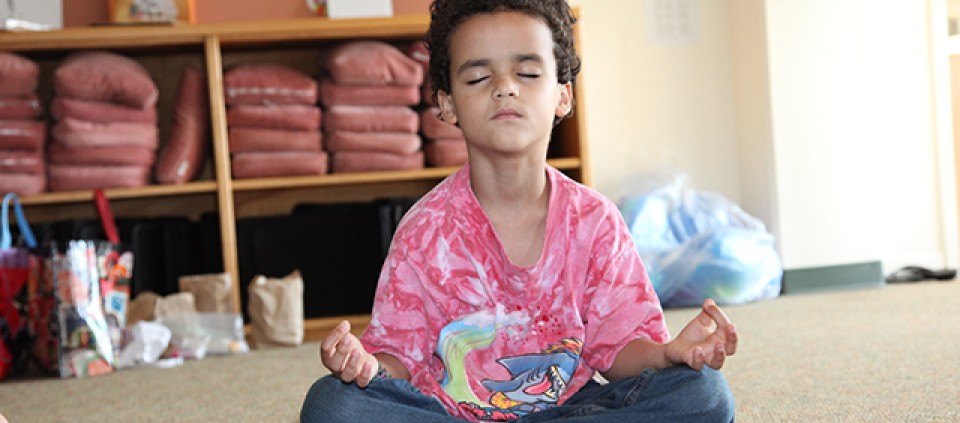The ABCs of Yoga

Yoga for children, says teacher trainer Shakta Khalsa, isn’t just a scaled-down version of yoga for adults—it’s a whole different animal. For example, a teacher might lead postures by asking children to “make a mountain” with their bodies (that would be Downward Facing Dog) or become a “fearless warrior.” A breath-awareness exercise could be as simple as blowing on a feather, first gently and then more forcefully, and noticing how these different types of breathing affect the way you feel. The language is different, too: yoga teachers may have to unlearn some very basic habits, such as using the words inhale and exhale. “Kids may not know what those words mean,” Shakta says.
A certified 500-hour Kundalini Yoga teacher, Shakta first taught yoga to children when she was living in a Kundalini community in Baltimore in the mid-1970s. There, both children and adults practiced yoga daily, and the grown-ups took turns teaching the kids. “I discovered that it was something I loved,” Shakta says, and her warm presence and gentle voice confirm that she’s a natural fit for the role.
“I love children’s fresh, wise, and innocent perspective on life, which comes out in our ‘yoga play’ together,” Shakta says. “I find, quite often, that they are just as much my teachers as I am theirs, and I find that thrilling. It grows the love and connection to spirit exponentially to be in a room of creative, happy children who are learning yoga tools to stay happy and connected to their potential.”
Shakta was certified as a Montessori teacher in 1982 and opened her own school. When she moved to Virginia with her husband and son in 1991, she contacted Montessori schools and daycare centers about bringing yoga into their curriculum. “Within two weeks, I was teaching 500 kids a week,” she says. Fly Like a Butterfly: Yoga for Children, which Shakta published in 1999, was one of the first guides for teaching yoga to kids. In 2000, Shakta developed the Radiant Child Yoga teacher training, which now offers 200-hour, 95-hour, and 30-hour trainings, including one she offers at Kripalu in June.
The changing demographics of Shakta’s students over the past decade have reflected yoga’s growing reach. “In the beginning, it was parents and occasionally yoga teachers who wanted to add children’s yoga to their offerings,” she says. “Around 2004, I started seeing professionals—preschool teachers, private school teachers. A couple of years later, I was seeing occupational therapists and pediatric therapists. Now half the class is always professionals who already work with kids. It says to me that people are getting good results using natural methods like yoga to help children live up to their potential.”
Evidence-based research show that yoga’s benefits for kids include improved proprioception (sense of the body in space), balance, and focus, and decreases in stress and behavioral issues. Yoga is particularly beneficial for children with ADHD and autism, says Shakta, who offers a teacher training designed for this population. “These children don’t have a strong sense of self or good muscle awareness, and yoga can help with both these things.” Studies show that yoga also helps calm the nervous system and integrate the functioning of the two hemispheres of the brain. In a world where kids start using electronic equipment at increasingly younger ages—and spend more and more time on them as they get older—simply taking their eyes off the screen and moving their bodies is a benefit.
For the kids, the most important part is that yoga has to be fun. “It has to meet them where they are,” Shakta says. For the littlest ones, yoga could mean stories and songs that encourage them to move and stretch as they act out the words and postures, embodying roaring lions and peaceful trees. From age nine up, the goal is to give children concrete tools that they can translate into their lives off the mat. Practicing Tree pose, for example, develops focus and attention, which kids can tap into when taking a test or handling a stressful social situation. Shakta’s books and teacher trainings offer kid-friendly versions of meditation practices as well. A meditation could be as simple as singing a song, taking three or four slow breaths with awareness, or, for older kids, cupping your hands and blowing into them all the thoughts you want to let go of.
The proof of yoga’s efficacy for children, Shakta says, is in their faces and behavior. She sees and hears these stories every day: for example, the five-year-old who came back to Shakta’s class a few months after her mother had died. “When she left class, she had a big smile on her face, and her grandmother said this was the happiest she’d seen her since her mother died,” Shakta says. Or the eight-year-old boy who would get so angry in the classroom that he’d become violent—until his teacher, who had taken Shakta’s training, introduced him to the blowing-on-a-feather practice. “When he got really distraught, this was the one thing that helped him,” Shakta says. “He would hold the feather and blow on it again and again. Every time, like magic, it would help him to calm down and get his energy under control.”
For parents and grandparents introducing yoga to their children, Shakta recommends making it fun and enticing, while keeping in mind the foundation of the practice: as she puts it, “becoming more aware of yourself from the inside out.” Ultimately, yoga for children—like yoga for adults—is about feeling healthier and happier. “It’s not about making them perfect little yogis,” Shakta says. “The point is to let them know that yoga is part of our lives and can be a helpful tool. What matters is that children know how to go back to their place of happiness and find their center.”
© Kripalu Center for Yoga & Health. All rights reserved. To request permission to reprint, please e-mail editor@kripalu.org.